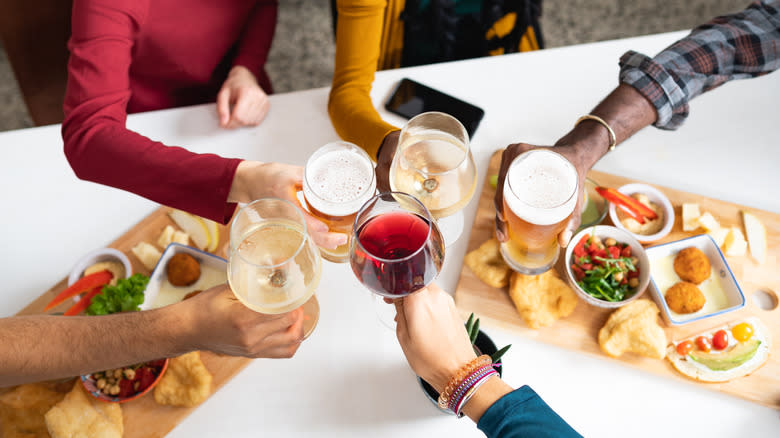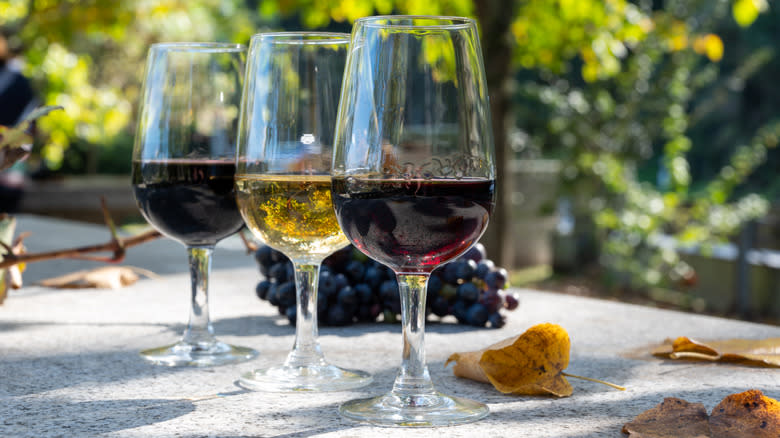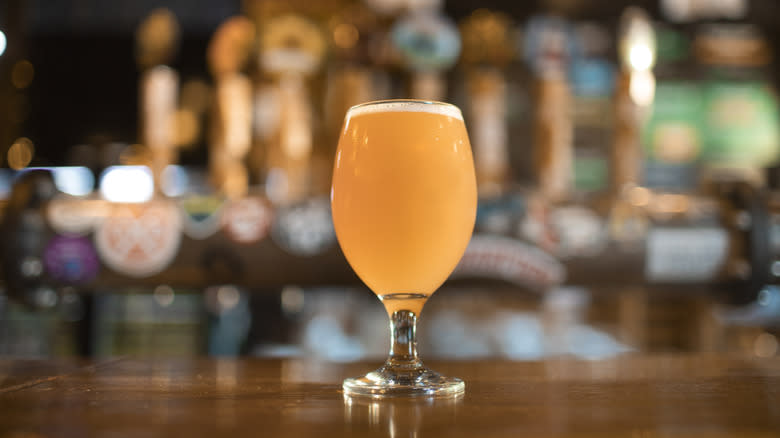Here's How Many Beers You'd Have To Drink To Equal A Bottle Of Wine

While plenty of people care about alcohol's ingredients or flavors, many drinkers are just as concerned with its effects. Of course, different types of alcohol offer different levels of potency. Take beer and wine, for example. Beer typically has a lower alcohol by volume (ABV) compared to most wine, meaning it's less potent. Bottles of beer are also smaller than bottles of wine, which means there's some number crunching required to determine how many bottles of beer are in a single bottle of wine.
In this case, consider that an average bottle of beer has an ABV of about 5%. Comparatively, an average bottle of wine usually has 12% ABV. Also, keep in mind that a bottle of wine may contain about 25 ounces, whereas a bottle of beer typically holds just 12 ounces. When factoring in the difference in ABV, and the fact that 12% wine is typically served in a 5-ounce glass, drinking five 12-ounce beers with 5% ABV will roughly equal the strength of one bottle of wine with an ABV of 12%.
Read more: The Ultimate Vodka Brands, Ranked
Not All Wines Have The Same ABV

In the wild and woolly world of alcoholic beverages, ABV fluctuates considerably. This is especially true of wine, which usually offers a wide range of potency that may impact comparisons to beer. On the low end of the scale, certain types of sparkling wine may fall below the average. For instance, something like prosecco could actually have an ABV lower than 12%. Accordingly, a lower number of 5% beers would equal one bottle of low-voltage carbonated wine.
White wines can have relatively low ABVs, but it depends on the variety. Consider that some types of chardonnays may have an ABV as high as 14.5%. Additionally, fortified wines like sherry can be greater than 14.5% due to the addition of a higher-proof distilled spirit (usually brandy). For instance, a dry sherry called Oloroso can have an ABV ranging from 17% to 22%. Red wines are also generally more potent than white. This is particularly true when it comes to port, another type of fortified wine. Take Ruby Port, which packs quite a punch at 20% ABV. As a result, you would need to drink a greater number of 5% ABV beers to equal one bottle of high-potency wine, unless the brew you're drinking is also quite potent.
What About The High ABV Found In IPAs?

India pale ales (or IPAs) are a style of beer brimming with hops, which is what gives these brews their characteristically bitter bite. While IPAs have been around since the 1700s, they've excelled in popularity over the last three decades or so. IPAs are now pretty popular and ubiquitous; they're also beloved for their high ABV as much as their powerful flavor.
Standard IPAs usually have an ABV ranging from 6% to 7%. However, there are also double and triple versions of IPAs, which range from 7.5% to 12%. Some IPAs go even harder when it comes to potency. Consider that the 120 Minute IPA from Dogfish Head Brewery features an ABV ranging from 15% to 20%. That means a single bottle of beer may rival the alcohol content found in a full bottle of wine. Thanks to the varying potency of beer and wine, the brand and type of alcohol you're drinking can play a major role when comparing ABVs.
Read the original article on Daily Meal.

